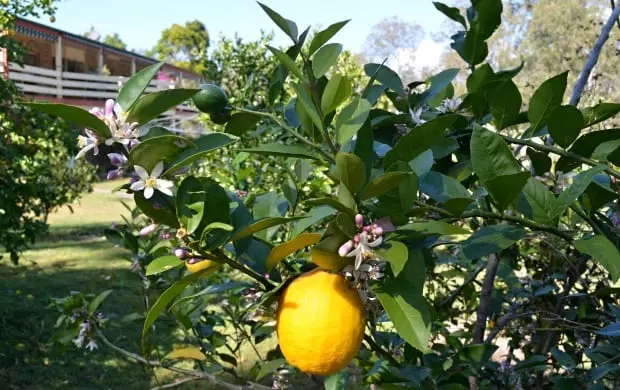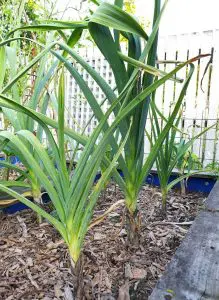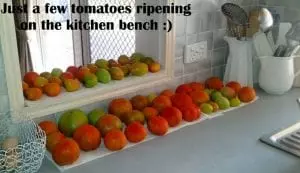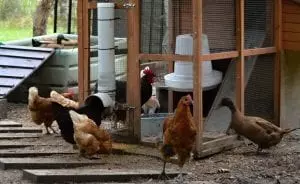This transcription of our popular How to Grow a Ton of Lemons video has been requested several times so here it is! The video is at the end…
G'day! I'm Mark from Self Sufficient Me and in this video, I'm going to give you my 5 top tips on how to grow a ton of lemons on just one tree!

Tip # 1 – Position
This is one of the most important things you can do when sighting and planting a lemon tree is to ensure that it's located in the right spot.
Things that you need to consider for a lemon tree to thrive like this is to plant it first of all in an area where it's not going to compete for too much for light – lemon trees like full sun. This is a fruit bearing tree and it produces lots of fruit that means it takes lots of energy and how does a tree like this get most of its energy? And, where does it get it from? The sun – sunlight.
So whenever possible plant your lemon tree for best results in full sun. Now, lemon trees do like warm weather but say you were in a cool climate what you can do is plant the tree in a warm spot maybe against a sunny wall that gets sun most of the day and that wall is heated up throughout the day during the coldest time of year so it can at least grow happily through the cool winter months and then thrive through the summer months and spring time.
Let's just quickly touch on the soil aspects of a lemon tree because we really don't need to go too much in depth and the reason for that is lemon trees are just so hardy! They will grow in just about any conditions and in any soil the other thing it has is an extensive fibrous feeder root system that's almost on the surface. If you scratch around the surface of this tree or any mature tree or even smaller trees you will find that they have fibrous roots just underneath the surface and this makes them very adaptable to grabbing any type of moisture whether it be dew or small amounts of rainfall, and it can really suck that moisture up and the nutrients and the minerals and make the best use of it.
Speaking about the root system that leads me onto…
Tip # 2 – Mulching
This is just a quick tip but nevertheless, it's really, really important and one of the main reasons why I've got so much success out of growing lemons.
I mulch our lemon tree like crazy! Like I mean, I don't continually mulch it every day or anything but when I do put mulch down I will lay it on thick – sometimes like a foot deep and the reason for that is, you know that fibrous root system I was talking about, they do love protection and if you give it protection from the harsh sun or the cold weather through winter and you keep that root system nice and cool and keep the moisture in by mulching deeply well then that's going to give it more chance to suck up all those nutrients.
The other thing that mulch does is that as it breaks down it adds extra nutrients to the soil and to the root system. What type of mulch do you use? You can use anything, what I have got here is a mixture of things I have gathered from around the yard: twigs, sticks, leaves, even old rotten fruit that I've just left underneath the tree. The main point is to lay the much down under the tree nice and thick and mulch it heavily right out to the drip line or canopy of the tree and your lemon tree will love you for it.
Tip # 3 Fertilise
Now you can do this in two ways, you can either use natural fertilisers such as manures you get from your own animals like chickens, ducks, horses or you can buy it from the stables and apply that to the tree or you can use a commercial fertiliser – the granulated stuff that you get from the shop or nursery.
Both are good and I have used both and I have to say personally I like using the commercial stuff and I'll tell you why because many manures won't have all the essential trace elements. Things like zinc, iron, and all those special minerals that a lemon tree needs to grow which it may not be getting from the soil either so the thing to note is if you intend to use a manure – that's fine – but you may need to buy some separate trace elements (not fertiliser but the actual trace elements) where you can get a few scoops into a watering can and sprinkle it around the tree or you can get a granulated trace element pack that you throw a few handfuls underneath the tree and that's usually enough.
So remember, if you are using a straight manure it may not have everything. On the other hand, if you are using a commercial fertiliser – a citrus fertiliser usually comes with trace elements added in it and I recommend a citrus fertiliser that does say on the pack: "citrus fertiliser with trace elements" and that way you don't have to go and buy the trace elements separately.
That will then cover all the extra nutrition, the micro nutrients and minerals it needs plus the fertiliser it needs to grow nice big fat fruit.
Now, in tip # 2 I talked about mulch – when you are fertilising the best way to do it is add the fertiliser after you have put the mulch down. So if your mulch has run low, put new mulch down nice and thick and then wack the fertiliser around and if it's manure you will probably need to have a real liberal spread of manure around that tree. A couple of inches deep, nice well-rotted manure remember, and spread evenly right around the tree spread evenly about a foot out from the trunk and right out to the drip line – a nice thick layer but on top of that mulch.
If you are using a commercial fertiliser, well for a tree this size I would use about 5 or 6 handfuls of a complete fertiliser with trace elements and I would throw that liberally around and on top of the mulch in an even way right out to the drip line at about a foot out from the trunk so it's not too close to the trunk and it's not burning any of those feeder roots.
After you have fertilised you'll want to give it a good water in as well, that fertiliser will then drip feed through the mulch over a period of time and give your plant an extended feed over several months and extended micro nutrients that it needs to produce really well and stay healthy rather than a big quick hit that might over do the plant and make it grow too leggy and over green but not much fruit.
If you are using a commercial fertiliser look at the manufacturers' instructions and apply that strictly to what the manufacturer says. Don't go over board and kill it with love – if you put too much fertiliser down you will kill the tree with love or it just won't perform because it has been over fertilised and over stimulated and you might get a lot of leafy growth but not a lot of fruit. You want to give it just the right amount and remember on top of that mulch that is the key.
Tip # 4 – Water
It sounds pretty simple but lemon trees do love a lot of water and watering at the right time is vitally important if you want a lot of fruit. The best time to start your watering regime is when this tree starts to flower and then the flowers drop and it starts to produce its fruit.
If you are giving a good amount of water to the tree making sure that of course it's not bogged down in a quagmire of bogginess (well, that's obviously silly) but giving it appropriate water making sure it's not drying out or needing a drink that's for sure when it's starting to form fruit it will keep its fruit and it will grow its fruit bigger because it will think that it can… It will think that the conditions are good so it will produce well.
Tip # 5 – Pests and Disease
Now you might be surprised to know that I don't pay a lot of attention to pests and disease. The thing is if you do the first four tips well your tree will be strong enough and happy enough to deal with most pest and disease outbreaks.
The last thing you want to do is micromanage your tree and go all worried and sick just because it has got a few aphids on it or a bronze orange bug here and there or a gall wasp or it's looking a bit sick. Don't go to the cabinet and bring out all the pesticides as this is the worst thing you can do because remember they are indiscriminate and if you use a pesticide on a tree like this you are also killing all the bees and other pollinating insects and also the predator insects that use the pests as feed and once you wipe them out it's like wiping out all the lions and tigers and then you are going to have all the other smaller animals flourish and go crazy and eat all the grass and turn the savanna into desert.
It's an extreme example I know, but what you are better off doing is leaving the tree to cope with the smaller outbreaks of aphids etc and don't worry about it so much. What I do have to say though, is if you do find that there is a major infestation on your tree try to find an organic way to get rid of it either by picking off pests by hand or by pruning the tree back and getting rid of diseased leaves and branches.
That is the best way to combat pests and disease because having said everything I've said the last thing you want to do is have your tree suffer from a major infestation and that will affect how much fruit you get.
So yes watch it, if it's a small outbreak like the odd caterpillar then fine just let it have its fill and it will turn into a butterfly and fly off don't break out the pesticides – if it's a major infestation say citrus borer and you see a whole branch die off well then you need to take action don't you so it's a little bit of give and take there and wherever possible use organic means because the last thing you want to do is poison the environment kill all those predator insects and those pollinating insects and also have residual poisons in the fruit that you are going to eat – that's just not helpful at all is it.
And that's it! That's my five big tips on how to grow a ton of lemons on your lemon tree.
Position, mulch, fertilise, water, and pests. If you do all those 5 things you will grow a lot of fruit and have a very happy fruit tree.
Thanks a lot for watching don't forget our Website Self Sufficient Me, give us a thumbs-up, and subscribe if you haven't already.
Bye for now… Beautiful haha…
Video on how to grow a lot of lemons one just one tree
https://www.youtube.com/watch?v=PRzD0W0MB30&t=26s













